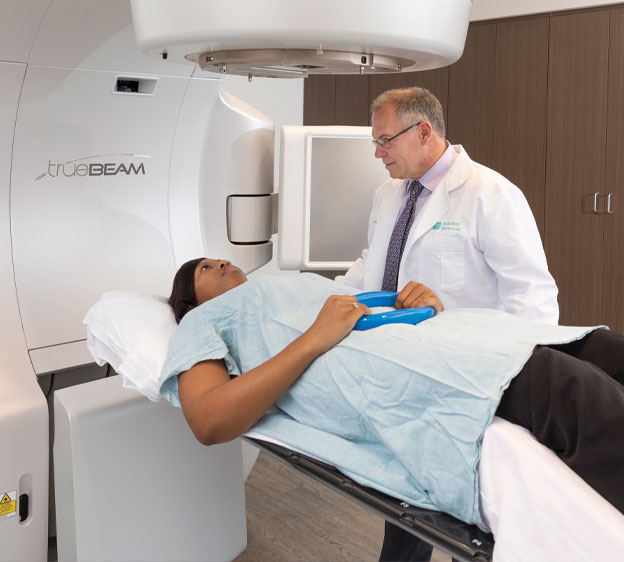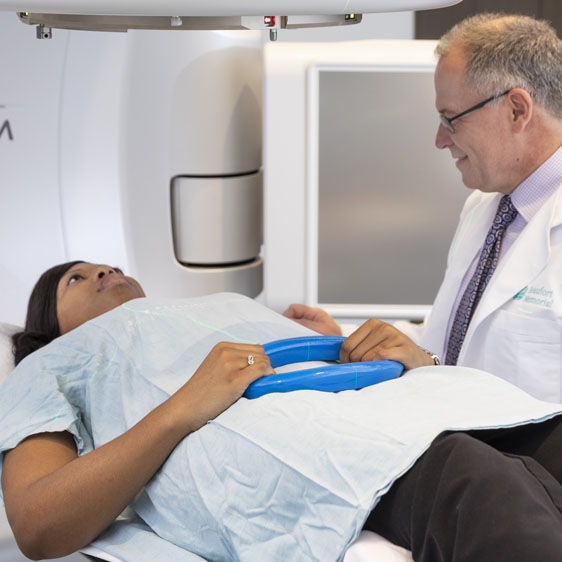
Facing a cancer diagnosis involves making many decisions about your treatment options. You might be compelled to turn to the Internet for help making those decisions, but that can lead you down a rabbit hole of uncertainty and misinformation. That’s often the case with radiation treatment.
“Radiation therapy is a widely used cancer treatment and one that can be very effective,” says Dr. Jonathan Briggs, a board-certified radiation oncologist at the Beaufort Memorial Keyserling Cancer Center. “Unfortunately, there are many misconceptions about how it works and what it does to the body. Having a better understanding of radiation therapy helps ensure you’re making the right decision for your care.”
Your radiation oncologist and nurse navigator can answer specific questions you have about your treatment plan and what to expect. In the meantime, we’re busting a few myths about this common treatment.
Read More: Radiation 101: What to Expect During Radiation Treatment for Cancer
Radiation Treatment Basics

Radiation oncologists use radiation therapy to treat many types of cancer, and according to the American Cancer Society, more than half of all cancer patients receive it as part of their treatment plans.
There are different types of radiation therapy, which operate in different ways. Your specific radiation treatment plan will depend on the type of cancer you have, as well as the stage of cancer. There are three primary forms of radiation treatment: external-beam radiation therapy, internal radiation therapy and systemic radiation therapy.
During external-beam radiation therapy, a machine called a linear accelerator aims high-energy radiation beams at a tumor or area of your body. As with other types of radiation therapy, the goal is to destroy cancer cells while avoiding healthy tissues. Forms of external-beam radiation therapy include:
- Image-guided radiation therapy
- Intensity-modulated radiation therapy
- Proton beam therapy
- Stereotactic body radiation therapy
- Volumetric modulated arc therapy
Internal radiation therapy works by placing radioactive material inside the body. Once placed in the tumor or surrounding tissue, this material delivers radiation directly to the cancerous cells. Internal radiation therapy, sometimes called brachytherapy, can use permanently implanted seeds or temporary radiation that clears out of the body after a few days.
The last form of radiation therapy, systemic radiation therapy, works similarly to internal radiation therapy. However, instead of implants or seeds placed near a tumor, systemic radiation therapy uses radioactive material that is swallowed or injected and targets cancer cells throughout the body.
The Facts About Radiation Treatment
If you’re still a little confused about radiation treatment, it may be helpful to read through these myth-busters:
Myth: If you have cancer, you’ll always need radiation treatment.
Fact: Your oncology team may not feel radiation therapy is right for you. Your care team has your best interests at heart and will choose the right treatment for your type and stage of cancer. If they recommend radiation, they’ll determine which type will work best.
Myth: If you have radiation therapy, you won’t need other cancer treatments.
Fact: You may have radiation therapy as a primary treatment, but it’s often used alongside other treatment options. Your oncologist may use radiation therapy before other treatments to shrink a tumor (neoadjuvant radiation therapy) or after other treatments to destroy any lingering cancer cells (adjuvant radiation therapy).
Finally, some patients receive palliative radiation therapy, or radiation therapy to relieve symptoms of cancer or side effects of treatment.
Read More: Others With Cancer Provide Help and Healing
Myth: When you receive radiation treatment, you can spread radiation to others.
Fact: This isn’t entirely true, and the reality depends on the form of radiation therapy you receive. Internal and systemic radiation therapy can cause your body to give off small amounts of radiation for a short time. When receiving these types of radiation therapy, you may be asked to keep a certain distance from people sensitive to radiation exposure, such as children and pregnant women. Patients being treated with external beam radiation are not “radioactive” when they leave the department and do not give off any radiation.
Myth: Radiation therapy will make me very sick.
Fact: Every person reacts differently to cancer treatments. Radiation therapy can cause fatigue and skin changes, such as rashes and irritation.
You may experience other side effects related to the area being treated (depending upon which part of the body is being treated). Radiation to the head and neck, for example, may cause dryness or sores in the mouth or difficulty swallowing.
Myth: If I have radiation treatment, it will cause me to develop another kind of cancer.
Fact: Patients who have radiation treatment are at a small but increased risk of developing a second cancer, which is a new cancer and not a recurrence of the original cancer, later in life. The risk of this side effect is low. To protect your health, talk with your care team about signs you should watch for.
“A cancer diagnosis can be overwhelming, and we encourage all patients to discuss questions and concerns with their care teams,” Dr. Briggs says. “It’s our goal to ensure you have the information you need to feel confident in your care decisions and understand the treatments you have.”
Have other questions about your cancer treatment? Contact a nurse navigator who can answer them for you.

